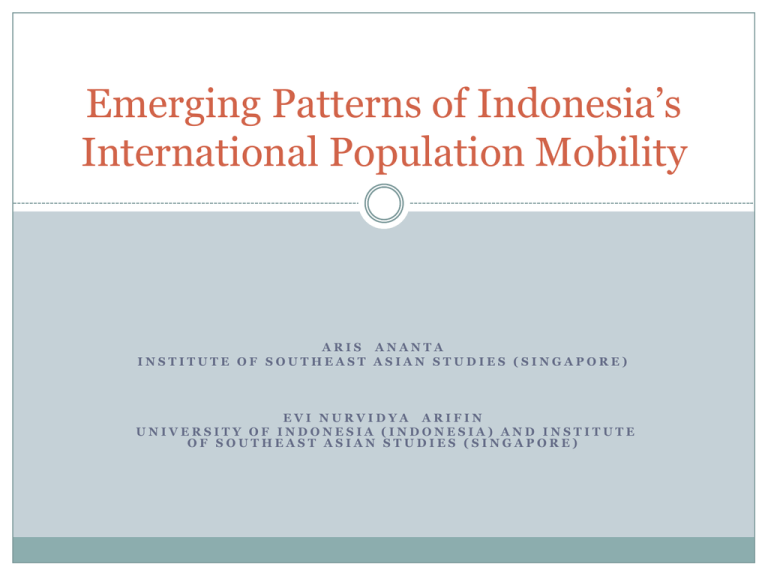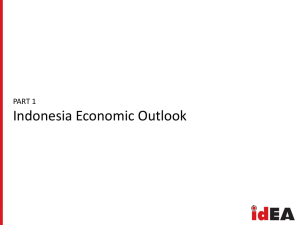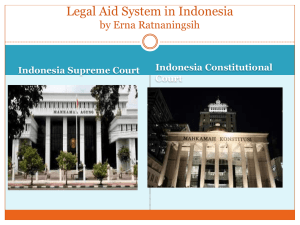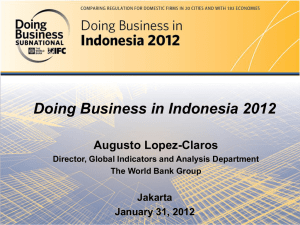Power Point - Population Studies Unit, University of Malaya
advertisement

Emerging Patterns of Indonesia’s International Population Mobility ARIS ANANTA INSTITUTE OF SOUTHEAST ASIAN STUDIES (SINGAPORE) EVI NURVIDYA ARIFIN UNIVERSITY OF INDONESIA (INDONESIA) AND INSTITUTE OF SOUTHEAST ASIAN STUDIES (SINGAPORE) Different Population Issues: Past, Now, and Future Size Age-Sex Composition Geographical Distribution Economy Society Politics Environment Fertility Migration Mortality Migration consists of both internal and international migration Three Mega Demographic Trends: Large and Increasing Size, Ageing Population, and Changing Pattern of Population Mobility “Theories” of Demographic Transition: Vital Transition “Usual” (Vital) demographic transition First demographic transition From high fertility and mortality rates to low fertility and mortality rates, usually at replacement level Second demographic transition Fertility and mortality are below replacement level. Shortage of Labour. In-migration. Changes in social and political values. More difficult to be engineered, more aspiration for self-fulfillment. “Theories” of Demographic Transition: Population Mobility “Mobility transition Internal (within a country) population mobility: From short to long, and “return” to short distant mobility. From “permanent” to temporary mobility. Higher frequency of mobility. International population mobility At low level of development, more capital in-flow and labour out-flow. Usually at per capita GDP of, perhaps, less than US$ 1,000 At a point, labour out-flow stops and labour in-flow starts. It is possible to have both capital in-flow and labour in-flow at the same time. Perhaps, a turning point will be reached at per capita GDP between US$3,000 and US$4,000 A further point is reached when capital in-flow disappear, and capital out-flow starts. Perhaps, at per capita GDP of more than US$10,000 Mega Demographic Trends in Indonesia Increasingly Large Number of Population An emerging global economic powerhouse, partly because of its large number of population Indonesia is seen as a lucrative market and production base. Because of its large size, international out-migration from Indonesia will also be large, at least in absolute number.With a smaller family size, a large number of young adult population has more opportunity to be more mobile, including moving (permanently or temporary, including studying) to other countries. Ageing Population – an emerging geriatric wave Fertility at national level is almost at replacement level. However, in some sub-national levels, fertility is already below replacement level. It can be a burden for the society It may also mean rising number of older persons on the move. More elderly tourists and commuters. More medical tourism Changing Internal Population Mobility Increase in flow, frequency, and distance until 2000. Long-term mobility declined during 2000-2010. Short-term mobility increased during 2000-2010 It is possible that people move more on non permanent basis, moving without changing their residences as allowed by a better transportation system, including availability of budget air fares. As an illustration, domestic airports have become increasingly busier. Airline has become a very lucrative business. Will it affect international migration? Will it increase the demand to visit other countries? This may mean that Indonesian economy may have become more integrated domestically. It may mean that Indonesia has become a more lucrative market and production base and very beneficial to ASEAN Economic Community. Changing International Population Mobility: competing with domestic destinations As transportation cost to neighbouring countries has become cheaper, and even cheaper than moving to other regions within Indonesia, people start to increase their international population mobility. Shopping, medical tourism, or other tourism to Singapore and Malaysia may have competed with those to other regions within Indonesia. The World as new “gardens” The whole world is their new gardens to explore: to work, to study, to live, and to visit. However, the supply of low-skilled workers (including domestic workers) will decline after 2020 or sooner because of declining fertility, rising education and economic opportunity, and rising awareness on human rights. Indonesia as a magnet for foreigners Indonesia has also become increasingly attractive place to explore for people from outside Indonesia They come to visit (as tourists), to work, to study, and to live. Unfortunately, this group also includes those who are not desired such as doing smuggling, illegal trading and working. They are no longer limited to high skill workers (and expatriates), but include middle level and even lower level workers (such as miners). These foreigners compete the local in many areas, labour market, goods market, and public services. Interaction with different ways of life has been seen more frequently Returning to Indonesia Indonesians who used to live overseas may start returning to Indonesia as they become older Younger Indonesians may have been attracted to return to Indonesia too because of rising business attractiveness in Indonesia. This groups of returning Indonesians may bring important social remittances to the local. Concluding Remarks (1) The population mobility within Indonesia will continue to rise with more commuting (non permanent mobility), thanks to the rising income, better and cheaper transportation system and telecommunication technology. This will help integrating Indonesian within ASEAN Economic Community. The rising internal mobility is accompanied by rising international population mobility, particularly to neighbouring countries Concluding Remarks (20 The discussion and policies on ASEAN Economic Community cannot ignore or avoid the demand for more freedom of people movement from and into Indonesia, at least within Southeast Asia. If their movement is stopped, they will come from the back door. It does not necessarily mean illegal entry. It may mean more outsourcing. If they cannot come from the back door, they may try from the side door. However, rising labour cost and low fertility in Indonesia may reduce the supply of low-skilled labours from Indonesia Thank You






